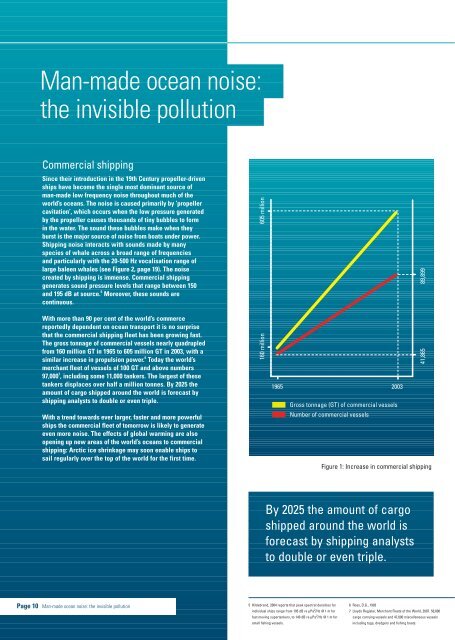Ocean Noise: Turn it down - Ocean Conservation Research
Ocean Noise: Turn it down - Ocean Conservation Research
Ocean Noise: Turn it down - Ocean Conservation Research
You also want an ePaper? Increase the reach of your titles
YUMPU automatically turns print PDFs into web optimized ePapers that Google loves.
Page 10<br />
Man-made ocean noise:<br />
the invisible pollution<br />
Commercial shipping<br />
Since their introduction in the 19th Century propeller-driven<br />
ships have become the single most dominant source of<br />
man-made low frequency noise throughout much of the<br />
world’s oceans. The noise is caused primarily by ‘propeller<br />
cav<strong>it</strong>ation’, which occurs when the low pressure generated<br />
by the propeller causes thousands of tiny bubbles to form<br />
in the water. The sound these bubbles make when they<br />
burst is the major source of noise from boats under power.<br />
Shipping noise interacts w<strong>it</strong>h sounds made by many<br />
species of whale across a broad range of frequencies<br />
and particularly w<strong>it</strong>h the 20-500 Hz vocalisation range of<br />
large baleen whales (see Figure 2, page 19). The noise<br />
created by shipping is immense. Commercial shipping<br />
generates sound pressure levels that range between 150<br />
and 195 dB at source. 5 Moreover, these sounds are<br />
continuous.<br />
W<strong>it</strong>h more than 90 per cent of the world’s commerce<br />
reportedly dependent on ocean transport <strong>it</strong> is no surprise<br />
that the commercial shipping fleet has been growing fast.<br />
The gross tonnage of commercial vessels nearly quadrupled<br />
from 160 million GT in 1965 to 605 million GT in 2003, w<strong>it</strong>h a<br />
similar increase in propulsion power. 6 Today the world’s<br />
merchant fleet of vessels of 100 GT and above numbers<br />
97,000 7 , including some 11,000 tankers. The largest of these<br />
tankers displaces over half a million tonnes. By 2025 the<br />
amount of cargo shipped around the world is forecast by<br />
shipping analysts to double or even triple.<br />
W<strong>it</strong>h a trend towards ever larger, faster and more powerful<br />
ships the commercial fleet of tomorrow is likely to generate<br />
even more noise. The effects of global warming are also<br />
opening up new areas of the world’s oceans to commercial<br />
shipping: Arctic ice shrinkage may soon enable ships to<br />
sail regularly over the top of the world for the first time.<br />
Man-made ocean noise: the invisible pollution<br />
160 million 605 million<br />
1965<br />
2003<br />
Gross tonnage (GT) of commercial vessels<br />
Number of commercial vessels<br />
5 Hildebrand, 2004 reports that peak spectral dens<strong>it</strong>ies for<br />
individual ships range from 195 dB re µPa2 /Hz @ 1 m for<br />
fast moving supertankers, to 140 dB re µPa2 /Hz @ 1 m for<br />
small fishing vessels.<br />
89,899<br />
41,865<br />
Figure 1: Increase in commercial shipping<br />
By 2025 the amount of cargo<br />
shipped around the world is<br />
forecast by shipping analysts<br />
to double or even triple.<br />
6 Ross, D.G., 1993<br />
7 Lloyds Register, Merchant Fleets of the World, 2007. 50,000<br />
cargo carrying vessels and 47,000 miscellaneous vessels<br />
including tugs, dredgers and fishing boats.

















